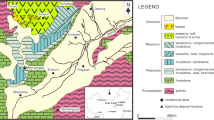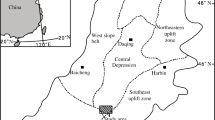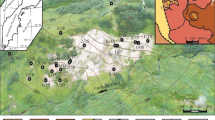Abstract
In the intermountain states, a region deficient in kaolinite and alumina clays, there is an increasing demand for refractory clay. In this arid region residual kaolins are not developed in quantity from feldspathic intrusives. Glassy, siliceous extrusives alter commonly to mont-morillonite of the montmorillonite-beidellite series. Zeolites, principally analcime and heu-landite, often are alteration products. Under certain conditions kaolinite, halloysite, or saponite will form; several tuffaceous deposits were investigated in an attempt to determine these environmental conditions, especially the physico-chemical environment necessary to produce kaolin clay.
Zeolites are developed where the pyroclastics are deposited in an alkaline lake; saponite is formed locally in this environment as a result of hot-spring activity. On river slopes and spurs the siliceous volcanics alter to kaolinite and montmorillonite; where associated with calcareous hot-spring activity in a fresh-water lake, halloysite results. Montmorillonite-beidellite develops where these special conditions do not obtain.
The prospects of finding a residual kaolinite deposit developed from siliceous volcanics are not good. Hydrothermal alteration appears to be the only means by which a siliceous volcanic will be converted to a sizeable refractory clay deposit in this region.
Similar content being viewed by others
References Cited
Ames, L. L., Jr., Sand, L. B., and Goldich, S. S., 1956, Contribution on the Hector, California, bentonite deposit (Abstract): Geol. Soc. Amer. Bull., v. 67, p. 1665.
Bramlette, M. N., and Posnjak, E., 1933, Zeolitic alteration of pyroclastics: Amer, Min., v. 18, p. 167–171.
Dietrich, W. F., 1928, The clay resources and the ceramic industry of California: Calif. Div. of Mines Bull. 99, 383 p.
Hampel, B. F., and Cutler, I. B., 1953, Some ceramic properties of halloysite: J. Amer. Ceram. Soc., v. 36, p. 30–34.
Kerr, P. F., and Cameron, E. N., 1936, Fullers earth of bentonitic origin from Tehachapi, California: Amer. Min., v. 21, p. 230–237.
Kirkham, V. R. D., 1931, Igneous geology of southwest Idaho: J. Geol., v. 39, p. 564–591.
Roy, Rustum, and Sand, L. ?., 1956, A note on some properties of synthetic montmorillonites: Amer, Min., v. 41, p. 505–509.
Sand, L. B., and Ames, L. L., Jr., 1956, Intermediate structures as a probable factor in halloysite genesis (Abstract): Geol. Soc. Amer. Bull., v. 67, p. 1731.
Schroter, G. A., and Campbell, Ian, 1942, Geological features of some deposits of bleaching clay: Trans. A.I.M.M.E., v. 148, p. 178–208.
Shannon, E. V., 1925, The so-called halloysite of Jones Falls, Md.: Amer. Min., v. 10, p. 159–161.
Stringham, B., and Sharp, B. J., 1950, The Fox clay deposit, Utah: Amer. J. Sci., v. 248, p. 726–733.
Wright, L. A., Steward, R. M., Gay, T. E., Jr., and Hazenbush, G. C., 1953, Mines and mine deposits of San Bernardino Co., Calif.: Calif. J. of Mines and Geol., v. 49, p. 49–192.
Author information
Authors and Affiliations
Rights and permissions
About this article
Cite this article
Sand, L.B., Ames, L.L. Altered Siliceous Volcanics as a Source of Refractory Clay. Clays Clay Miner. 5, 39–45 (1956). https://doi.org/10.1346/CCMN.1956.0050105
Published:
Issue Date:
DOI: https://doi.org/10.1346/CCMN.1956.0050105




